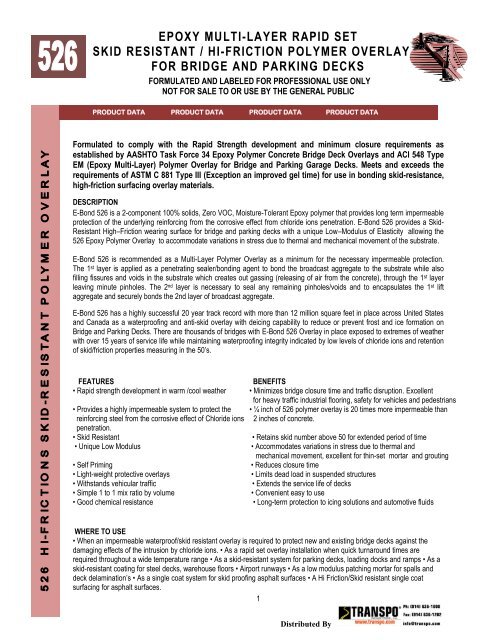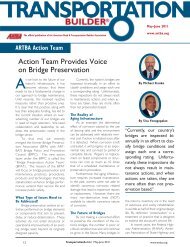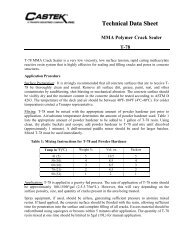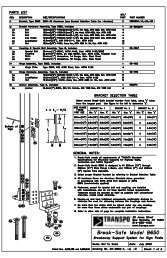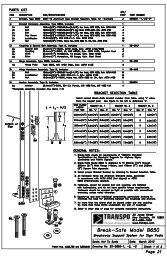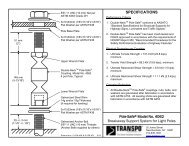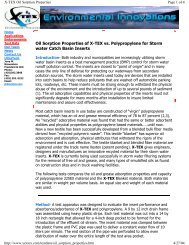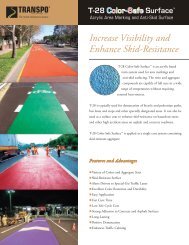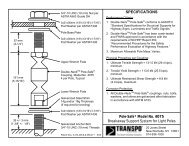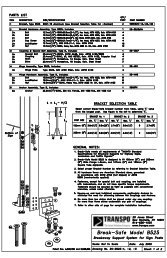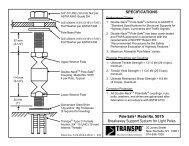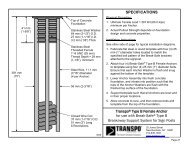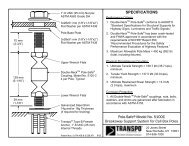Proposed Material Safety Product Data Sheet - Transpo Industries, Inc.
Proposed Material Safety Product Data Sheet - Transpo Industries, Inc.
Proposed Material Safety Product Data Sheet - Transpo Industries, Inc.
Create successful ePaper yourself
Turn your PDF publications into a flip-book with our unique Google optimized e-Paper software.
EPOXY MULTI-LAYER RAPID SET<br />
SKID RESISTANT / HI-FRICTION POLYMER OVERLAY<br />
FOR BRIDGE AND PARKING DECKS<br />
FORMULATED AND LABELED FOR PROFESSIONAL USE ONLY<br />
NOT FOR SALE TO OR USE BY THE GENERAL PUBLIC<br />
PRODUCT DATA PRODUCT DATA PRODUCT DATA PRODUCT DATA<br />
Formulated to comply with the Rapid Strength development and minimum closure requirements as<br />
established by AASHTO Task Force 34 Epoxy Polymer Concrete Bridge Deck Overlays and ACI 548 Type<br />
EM (Epoxy Multi-Layer) Polymer Overlay for Bridge and Parking Garage Decks. Meets and exceeds the<br />
requirements of ASTM C 881 Type III (Exception an improved gel time) for use in bonding skid-resistance,<br />
high-friction surfacing overlay materials.<br />
DESCRIPTION<br />
E-Bond 526 is a 2-component 100% solids, Zero VOC, Moisture-Tolerant Epoxy polymer that provides long term impermeable<br />
protection of the underlying reinforcing from the corrosive effect from chloride ions penetration. E-Bond 526 provides a Skid-<br />
Resistant High–Friction wearing surface for bridge and parking decks with a unique Low–Modulus of Elasticity allowing the<br />
526 Epoxy Polymer Overlay to accommodate variations in stress due to thermal and mechanical movement of the substrate.<br />
E-Bond 526 is recommended as a Multi-Layer Polymer Overlay as a minimum for the necessary impermeable protection.<br />
The 1 st layer is applied as a penetrating sealer/bonding agent to bond the broadcast aggregate to the substrate while also<br />
filling fissures and voids in the substrate which creates out gassing (releasing of air from the concrete), through the 1 st layer<br />
leaving minute pinholes. The 2 nd layer is necessary to seal any remaining pinholes/voids and to encapsulates the 1 st lift<br />
aggregate and securely bonds the 2nd layer of broadcast aggregate.<br />
E-Bond 526 has a highly successful 20 year track record with more than 12 million square feet in place across United States<br />
and Canada as a waterproofing and anti-skid overlay with deicing capability to reduce or prevent frost and ice formation on<br />
Bridge and Parking Decks. There are thousands of bridges with E-Bond 526 Overlay in place exposed to extremes of weather<br />
with over 15 years of service life while maintaining waterproofing integrity indicated by low levels of chloride ions and retention<br />
of skid/friction properties measuring in the 50’s.<br />
FEATURES<br />
• Rapid strength development in warm /cool weather<br />
• Provides a highly impermeable system to protect the<br />
reinforcing steel from the corrosive effect of Chloride ions<br />
penetration.<br />
• Skid Resistant<br />
• Unique Low Modulus<br />
• Self Priming<br />
• Light-weight protective overlays<br />
• Withstands vehicular traffic<br />
• Simple 1 to 1 mix ratio by volume<br />
• Good chemical resistance<br />
BENEFITS<br />
• Minimizes bridge closure time and traffic disruption. Excellent<br />
for heavy traffic industrial flooring, safety for vehicles and pedestrians<br />
• ¼ inch of 526 polymer overlay is 20 times more impermeable than<br />
2 inches of concrete.<br />
• Retains skid number above 50 for extended period of time<br />
• Accommodates variations in stress due to thermal and<br />
mechanical movement, excellent for thin-set mortar and grouting<br />
• Reduces closure time<br />
• Limits dead load in suspended structures<br />
• Extends the service life of decks<br />
• Convenient easy to use<br />
• Long-term protection to icing solutions and automotive fluids<br />
WHERE TO USE<br />
• When an impermeable waterproof/skid resistant overlay is required to protect new and existing bridge decks against the<br />
damaging effects of the intrusion by chloride ions. • As a rapid set overlay installation when quick turnaround times are<br />
required throughout a wide temperature range • As a skid-resistant system for parking decks, loading docks and ramps • As a<br />
skid-resistant coating for steel decks, warehouse floors • Airport runways • As a low modulus patching mortar for spalls and<br />
deck delamination’s • As a single coat system for skid proofing asphalt surfaces • A Hi Friction/Skid resistant single coat<br />
surfacing for asphalt surfaces.<br />
1<br />
Distributed By
E P O X Y M U L T I - L A Y E R R A P I D S E T<br />
HI- F R I C T I O N S K I D R E S I S T A N T P O L Y M E R O V E R L A Y<br />
F O R B R I D G E A N D P A R K I N G D E C K S<br />
PHYSICAL PROPERTIES<br />
(<strong>Material</strong> and curing conditions @ 75°F (24°C) and 50% R.H.)<br />
Mixing Ratio: Component A/B<br />
Viscosity:<br />
Gel Time:<br />
ASTM-D-2393 (poises)<br />
ASTM-C-881 ( 60 g) (minutes)<br />
Tensile Properties: (ASTM-D-638) Type I 7 day<br />
Tensile Strength<br />
Elongation at Break<br />
Adhesive Strength ASTM C 1583 – 04<br />
( mixed with aggregate) min. 250 psi (MPa 1.7)<br />
Bond Strength: (ASTM-C-882)<br />
2 day (moist cure) Plastic concrete to hardened concrete<br />
VOC mixed<br />
Compressive Properties: (ASTM-C-579) Method B<br />
3 hour Minimum<br />
1 day<br />
7 day<br />
Compressive Modulus ASTM D 695 14 day<br />
Thermal Compatibility ASTM C 884 (Mixed with aggregate)<br />
7 days<br />
Water Absorption: (ASTM-D-570) 7 days<br />
Permeability of Chloride Ions AASHTO T277 28 days<br />
(less than 100 coulombs)<br />
1:1 by volume<br />
15-30<br />
15-30<br />
2500-5000 psi (17-34 MPa)<br />
30-80%<br />
250+ psi( Mpa)<br />
1600 psi (11) min.<br />
0 g/l<br />
1000 psi (6.g/l9 Mpa)<br />
5000 psi (34 Mpa)<br />
6500 psi (45 Mpa)<br />
130,000 psi (896 Mpa) max.<br />
No delaminations<br />
0.4%<br />
73 (negligible)<br />
For Best Performance<br />
90°F<br />
32°<br />
40°F<br />
4° C<br />
Precondition the<br />
components to 70°F (23°C)<br />
to 80°F (27°C) for 24 hours<br />
before use.<br />
Minimum ambient, surface,<br />
aggregate and epoxy<br />
temperatures should be<br />
50°F (10°C) and rising at<br />
the time of application.<br />
Store at 40ºF (4.4ºC)-<br />
95ºF(35ºC)<br />
Protect from moisture.<br />
Protect from freezing.<br />
Do not add solvents or<br />
water to epoxy material.<br />
Do not alter or change the<br />
recommended proportions<br />
when blending the<br />
components.<br />
Layers<br />
85+<br />
(29+)<br />
Rapid Set times Minimum Closures times in Warm and Cool Weather Applications<br />
Average Temperature of Deck, Epoxy, and Aggregate Components in ˚F (˚C)<br />
84-80 79-75 74-70 69-65 64-60 59-55 *54-50 *49-45<br />
(29-27) (26-24) (23-21) (21-18) (18-16) (15-13) (12-10) (9-7)<br />
Hours 1 1½ 1 ¾ 1 ¾ 2 2 2 ¼ 2 ½ 2 ¾ 3<br />
*44-40<br />
(7-4)<br />
*It is highly recommended that all components be conditioned in advance of use to 75°F (24°C). This may take 48 hrs. It is to the contactors benefit to<br />
maintain the components at elevated temperatures. At lower temperatures (
Layer 1 4 gallons per 100 ft 2 ( 64 mils – 1/16”) 15 lbs/yd 2<br />
**Application of aggregate shall be of sufficient quantity until a dry layer of aggregate is present on the entire surface. If wet spots<br />
develop broadcast additional aggregate until a dry surface is re-established.<br />
Broadcast Aggregate for Bridge Decks<br />
Mesh/Metric #4 / 4.75 mm #8 / 2.36 mm #16 / 1.18 mm #30 / 0.600 mm<br />
% PASSING 100 30-75 0-5 0-1<br />
Broadcast Aggregate for Parking Decks<br />
Mesh/Metric #16 / 1.18 mm #20 / 0.850 mm #30 / 0.600 mm #40 / 0.425 mm<br />
% PASSING 51-75 14-50 0-25 0-2<br />
Aggregate shall be angular shaped silica, basalt, or other nonfriable aggregate with a hardness of 6.5 or greater clean and dry<br />
(less than 0.2% moisture, ASTM C 566), free from dirt, clay, asphalt, and other organic materials.<br />
Check List:<br />
<br />
<br />
<br />
<br />
<br />
<br />
<br />
<br />
<br />
<br />
SURFACE PREPARATION<br />
Surface Preparation is everything for the long term<br />
performance of the Epoxy Polymer Overlay. All soft weak<br />
surface mortar laitance or carbonation must be removed to<br />
allow the epoxy compound to bond to the aggregate within<br />
the concrete matrix.<br />
Quality Assurance Requirement to Qualify the Concrete<br />
Substrate and Verify Adequate Surface Preparation<br />
Prior to the application of the 1 st lift of the 526 polymer place<br />
a minimum of 3 test patches (approcx.1.5 ft. x 3 ft.) for every<br />
300 yd 2 in the wheel patch lanes or in other areas that<br />
represent a worst surface condition, Test in accordance<br />
with ASTM C 1538 “Standard Test Method for Tensile<br />
Strength of Concrete Surfaces and the Bond Strength or<br />
Tensile Strength of Concrete Repair and Overlay <strong>Material</strong>s<br />
by Direct Tension (Pull-off Method)” Tensile Rupture Test.<br />
The test failure should not be in the polymer overlay or the<br />
bond of the overlay to the substrate. The failure should be in<br />
the concrete substrate. The evaluation shall be the average<br />
of the three tests for each location which should have a<br />
pullout value of not less than 250 psi (1.7 MPa) with more<br />
than 50 percent of the failure area in the concrete at a depth<br />
of 1/4 in. (6 mm) or greater.<br />
Concrete<br />
Recommend Two (2) layer applications based on a proven record of more than twenty (20) years of maintaining low levels of<br />
chloride icon intrusion. A single layer has indicated that within two (2) years a breakdown of protection against chloride ion<br />
intrusion will occur.<br />
It is not recommended to allow traffic on epoxy polymer overlays between lifts. The 1 st layer of epoxy is applied at insufficient<br />
thickness to encapsulate a minimum of ½ the height of the aggregate. When epoxy is not fully set in cool weather, applications of<br />
heavy traffic can dislodge the aggregate.<br />
Set time is established by placing a blunt object (a coin, key etc.) against the top profile of the aggregate. The epoxy overlay is<br />
sufficiently set to open to traffic if the aggregate chips or breaks away at the top edge of the aggregate without rupturing or<br />
marring the base epoxy.<br />
Review curing schedules based on product and substrate.<br />
Polymer concrete overlay materials shall not be placed when weather or surface conditions are such that the material cannot be<br />
properly handled, placed, and cured within the specified requirements of traffic control.<br />
There shall be no visible moisture present on the surface of the concrete at the time of application of the polymer concrete<br />
overlay. Moisture should be tested by placement of a plastic sheet left taped in place for a minimum of 2 hr (ASTM D4263)<br />
Finished application is a vapor barrier, and is not recommended for on-grade exterior slabs (bridge ramps) where moisture-vapor<br />
transmission is a concern. If required consult E-Bond Technical Service re the use of a Moisture Barrier reduction coating.<br />
Do not place the epoxy polymer overlay on new concrete/patches less than 28 days of age (If earlier times are required contact<br />
E-Bond Technical Service).<br />
Magnesium phosphate patching materials require 30 days of curing before being overlain in to allow generated gasses to escape<br />
and special attention to roughened surface.<br />
Do not apply epoxy binder material on a wet surface or when anticipated weather conditions would prevent the proper application<br />
of the Epoxy Polymer Concrete Overlay.<br />
3<br />
All surfaces must be prepared to a structurally dense<br />
surface to expose coarse aggregate and reveal an open<br />
texture surface. Remove weak, contaminated deteriorated<br />
concrete, asphalt materials, oils, dirt, rubber, curing<br />
compounds, paint, carbonation, laitance, and other<br />
potentially detrimental materials by shot-blasting, bush<br />
hammering or other suitable mechanical means. Surface<br />
preparation by grinding or milling creates minute fractures or<br />
micro cracking in the substrate and leaves behind a<br />
concrete slurry or paste residue that is detrimental to the<br />
bond of the epoxy polymer overlay which necessitates shot<br />
blasting to remove the dried slurry and micro cracks.<br />
Hydro-demolition with ultra-high hydro blasting may leave<br />
irregular surface profiles leading to increased water<br />
absorption as well as concrete slurry or paste on the surface<br />
that is detrimental to the bond of the epoxy polymer overlay<br />
requiring removal by shot blasting.<br />
Steel<br />
Steel should be cleaned and prepared by sandblasting to<br />
conform to SSPC-SP10 Specification with a 4 mil (0.1mm)<br />
minimum anchor profile. If oil is present on the surface the<br />
Distributed By
euse of shot blast or sandblast media is not recommended<br />
to avoid re-contaminating the prepared surface. If flash rust<br />
appears, the surface must be re-blasted to obtain the<br />
minimum anchor profile. The overlay is to be applied within<br />
the hour after preparation and before flash rushing.<br />
oversize mixing containers. Mix thoroughly for a minimum of<br />
three minutes using a low speed drill (600 rpm) and a mixing<br />
paddle (e.g. a Jiffy® and/or Plunge Mixer). Keep the<br />
paddle below the surface material to avoid entrapment of air.<br />
During mixing it is important to carefully scrape the sides<br />
Asphalt<br />
New asphalt pavement - It is recommended that a period of<br />
two weeks to a month be allowed for the pavement to<br />
oxidize by trafficking.<br />
Existing asphalt pavement - Prior to application of the 526,<br />
the entire area must be power washed 20.7-48.3 MPa<br />
(3,000 - 7,000 psi) with a mild detergent to remove all dirt,<br />
grime, oil and loose contaminants that might affect the bond<br />
between the epoxy binder material and existing surfaces.<br />
Surfaces must be clean and dry; a hot compressed air lance<br />
may be required.<br />
Removal of existing overlays, asphalt etc.: Best removed<br />
by scarification, milling, grinding, bush hammering etc.<br />
Usually creates minute micro-cracking in the substrate<br />
requiring Surface Preparation to a structurally dense surface<br />
with an ICRI profile of CSP #5.<br />
Cleaning: If traffic has been allowed on the prepared<br />
surface or more than 7 days have elapsed since<br />
preparation, the surface will require additional cleaning to<br />
remove the early formation of carbonation and<br />
contamination by sandblasting (if permitted by local<br />
regulations due to health and environmental issues).<br />
Blow, sweep or power-sweep the surface area to be treated.<br />
Blow loose material from visible cracks using oil free, high<br />
pressure air blast.<br />
Temperature Effects: Mixing, Application & Working Time<br />
Epoxy and substrate temperatures have a direct effect on<br />
the usability of the epoxy compound. The quantity and<br />
temperature of the adhesive at time of mixing have a<br />
significant influence on the working time. Elevated<br />
temperatures will thin the epoxy making it easier to apply<br />
but will shorten the working time in the container resulting in<br />
less open time before early polymerization thereby affecting<br />
the bonding ability of the broadcast aggregate. Cooler<br />
temperatures thicken the epoxy, lengthen the working time<br />
in the container and extend the open time prior to the<br />
placement of the broadcast aggregate. Because of the fast<br />
cure rate of E-Bond 526 do not mix a quantity of epoxy at<br />
any one time that cannot be readily applied within the pot life<br />
in the container and the working time on the substrate at the<br />
prevailing temperature. Contact E-Bond Technical Service<br />
for assistance of the gel time in the container and working<br />
time on the substrate at different temperature ranges.<br />
MIXING<br />
For best results, prior to mixing condition the components to<br />
70°- 85°F (21°- 29°C).<br />
Mechanical Proportioning, Mixing: Place 1 volume of the<br />
resin Component (A) and 1 volume of the hardener<br />
component (B) into pre-calibrated flat wall and bottom<br />
containers. Dump the calibrated amounts into a clean<br />
4<br />
and bottom of the mixing container to ensure thorough<br />
mixing of the components. . Mix only the amount of material<br />
that can be used before the working time expires during<br />
application of the surface treatment system.<br />
Automatic Proportioning, Mixing: Mixing equipment that<br />
will automatically and accurately proportion the components<br />
in accordance with the manufacturer’s recommendations<br />
(+/- 2 percent by volume), mix and continuously place the<br />
polymer overlay.<br />
For assistance in the curing process when the substrate<br />
temperature is 75°F and falling, it is recommended that both<br />
components be preheated up 90±10°F (32.2°C) prior to<br />
blending. The operation should proceed in such a manner<br />
that will not allow the mixed material to separate, dry, be<br />
exposed or otherwise harden in such a way as to impair the<br />
retention and bonding of the high friction/Skid resistant<br />
surfacing aggregate.<br />
APPLICATION<br />
Concrete & Steel<br />
Multi Layer Epoxy Overlay Systems consist of two distinct<br />
steps: applying an epoxy polymer and a specified aggregate<br />
in two separate layers at the minimum polymer and<br />
aggregate application rates for the individual layers. (See<br />
application rate chart on page 2).<br />
1. The deck should be marked in sections to provide a<br />
visual guide to insure that the mixed quantity is applied<br />
at the specified rate (thickness).<br />
2. The mixed epoxy polymer is placed on the surface and<br />
immediately and uniformly spread by a notched<br />
squeegee at the coverage rate. Use continuous mixes<br />
(every 3 minutes), placing each successive mix<br />
immediately behind the former.<br />
3. Each batch should be dumped within 6 minutes and<br />
aggregate broadcasted immediately within 10-45<br />
minutes (Hot/Cool substrate) until a dry layer of<br />
aggregate is present over the entire surface. If wet<br />
spots develop, immediately broadcast additional<br />
aggregate until a dry surface is re-established.<br />
Accomplish aggregate broadcast while the epoxy is still<br />
fluid, but keep a wet edge.<br />
4. In cool weather applications 50-59°F (10-15°C)<br />
precondition all components to 80-100°F (27-38°C)<br />
before mixing and applying (consult E-Bond Technical<br />
service for other alternates). For cool applications a<br />
hand operated roller may be necessary to ensure the<br />
aggregate penetrates the cool resin.<br />
Distributed By
5. After the first layer of the overlay has cured, remove by<br />
brooming, or a high power vacuum or sweeper all<br />
excess unbounded aggregate.<br />
6. Repeat the application procedure for subsequent layers<br />
with coverage rates as specified for the 2 nd layer. The<br />
maximum recoat window is 24 hours.<br />
Asphalt- Follow application steps 1 through 5 above.<br />
AS A WATERPROOFING MEMBRANE BETWEEN<br />
ASPHALT OVERLAY AND CONCRETE: Spread the mixed<br />
526 by a notched trowel or squeegee at the rate of 40ft 2 per<br />
gallon (1.0m²/L). Place the epoxy in continuous operation.<br />
Broadcast a coarse aggregate approximately 16 to 20 mesh<br />
size. Allow to cure sufficiently to remove all loose aggregate.<br />
Asphalt topping can be applied after 24 hours.<br />
Proper application is the responsibility of the user. Field<br />
visits by E-Bond personnel are for the purpose of making<br />
technical recommendations only and not for supervising or<br />
providing quality control on the jobsite.<br />
PATCHING SPALLS, HONEYCOMBED AREAS,<br />
DELAMINATIONS, SMALL AND LARGE HOLES<br />
Procedure:<br />
Patches for spalls and repair areas greater than 1/2” (13mm)<br />
in depth should be saw cut 1-1½” deep depending on the<br />
depth of the repair and at least 2-3” beyond the perimeter of<br />
the repair area. USE CAUTION TO AVOID SAW CUTTING<br />
ANY STEEL.<br />
All concrete within the saw cut must be removed to the<br />
depth of the repair area. After removal the area should be<br />
sandblasted followed by an air blast to remove loose<br />
material and dust.<br />
Application:<br />
1. Pre-prime the surface with E-Bond 526 correctly mixed<br />
at 1:1by volume.<br />
2. To the mixed E-Bond 526 add approximately 2 ¾ to<br />
3 ½ volumes of 20 to 40 mesh washed and oven dried<br />
(or dry broadcast aggregate) aggregate to one volume<br />
of the mixed epoxy. Thoroughly blend the aggregate<br />
with the mixed epoxy components (mortar mixer) to a<br />
uniform mixture.<br />
3. Dump the mixed mortar onto the primed epoxy surface.<br />
Hard trowel the epoxy mortar to be flush with the deck.<br />
Excessive working of the epoxy mortar surface will<br />
bring resin to the top creating some resin float.<br />
Broadcast aggregate to refusal onto the leveled surface<br />
4. For large applications use screed box and a walkbehind<br />
trowel (designed for epoxy). Allow to cure. A<br />
terrazzo grinder can be used to remove high spots and<br />
ensure a continuous surface. Vacuum up any loose<br />
material.<br />
Machine mixing for Mortars and Patching Compounds:<br />
The polymer and aggregate for epoxy mortars/patching<br />
compounds can be machine mixed in small concrete or<br />
mortar mixers. Mix the components for 2-3 minutes prior to<br />
adding the filler aggregate. The proper ratio of resin-tocuring<br />
agents and polymer-to-aggregate for each batch<br />
should be maintained<br />
Note: Traffic shall not be allowed on the prepared deck<br />
surface prior to the application of E-Bond 526. A bond test in<br />
accordance with ASTM C 1538 “Standard Test Method for<br />
Tensile Strength of Concrete Surfaces and Overlay<br />
<strong>Material</strong>s by Direct Tension (Pull-off Method) is<br />
recommended to verify proper surface preparation<br />
5<br />
CLEAN-UP: Ventilate area. Confine spill. Collect with<br />
absorbent material. Dispose of in accordance with current,<br />
applicable local, state, and federal regulations. Uncured<br />
material can be removed with approved solvent. Cured<br />
material can only be removed mechanically. Clean tools and<br />
equipment with xylene immediately after using. Wash hands<br />
and skin with soap or Industrial hand cleaner, not with<br />
solvent. Cured material must be removed mechanically.<br />
Shelf Life: 1 year in original unopened container.<br />
Storage: Store Dry at 40ºF (4.4ºC)-95ºF(35ºC) .Condition<br />
to 65ºF (18ºC)-75ºF(24ºC) before using. Protect from<br />
inclement weather and freezing.<br />
Packaging: Available in 2 gallon units, 10 gallon units and<br />
110 gallon units. Totes available upon request.<br />
VOC Content:<br />
0 lbs/gal or 0 g/L, less water and exempt solvents<br />
CAUTION - For professional use only; not for sale to<br />
or use by the general public. E-Bond’s epoxies contain alkaline amines.<br />
Strong sensitizer; MAY CAUSE SKIN SENSITIZATION or allergic response<br />
ranging from a mild wheezing to a severe asthmatic type attack. Avoid<br />
contact with skin or eyes. IN CASE OF CONTACT immediately wash skin<br />
with soap and water. Flush eyes with water and obtain medical attention.<br />
Wear protective clothing, goggles, and barrier cream on all exposed skin.<br />
LIMITED WARRANTY NOTICE: Every reasonable effort is made to<br />
apply E-BOND exacting standards both in the manufacture of our<br />
products and in the information which we issue concerning these<br />
products and their use. We warrant our products to be of good quality<br />
and will replace or, at our election, refund the purchase price of any<br />
products proved defective. Satisfactory results depend not only upon<br />
quality products, but also upon many factors beyond our control.<br />
Therefore, except for such replacement or refund, E-BOND MAKES<br />
NO WARRANTY OR GUARANTEE, EXPRESS OR IMPLIED,<br />
INCLUDING WARRANTIES OF FITNESS FOR A PARTICULAR<br />
PRODUCTS, and E-BOND shall have no other liability with respect<br />
thereto. E-Bond excludes any warranty for discoloration or change in<br />
visual appearance of the product due to accumulation of or streaking of<br />
dirt or other airborne materials deposited on the surface from the<br />
atmosphere. E-BOND does not warrant the colorfastness of any<br />
product. Any claim regarding product defect must be received in writing<br />
within one (1) year from the date of shipment. No claim will be<br />
considered without such written notice or after the specified time<br />
interval. User shall determine the suitability of the products for the<br />
intended use and assume risks and liability in connection therewith.<br />
Any authorized change in the printed recommendations concerning the<br />
use of our products must bear the signature of the E-BOND Technical<br />
Manager.<br />
PURPOSE OR MERCHANTABILITY<br />
This information and all further technical advice are based on E-<br />
BOND's present knowledge and experience. However, E-BOND<br />
assumes no liability for providing such information and advice including<br />
the extent to which such information and advice may relate to existing<br />
third party intellectual property rights, especially patent rights. In<br />
particular, E-Bond disclaims all CONDITIONS AND WARRANTIES,<br />
WHETHER EXPRESSED1OR IMPLIED, INCLUDING THE IMPLIED<br />
WARRANTES OF FITNESS FOR A PARTICULAR PURPOSE OR<br />
MERCHANTABILIY. E-BOND SHALL NOT BE RESPONSIBLE FOR<br />
Distributed By
CONSEQUENTIAL, INDIRECT OR INCIDENTAL DAMAGES<br />
(INCULDING LOSS OF PROFITS) OF ANY KIND. E-BOND reserves<br />
the right to make any changes according to technological progress or<br />
further developments. It is the customer’s responsibility and obligation<br />
to carefully inspect and test any incoming goods. Performance of the<br />
product(s) described herein should be verified by testing and carried<br />
out by qualified experts. It is the sole responsibility of the customer to<br />
carry out and arrange for such testing. Reference to trade names used<br />
by other companies is neither a recommendation, nor an endorsement<br />
of any product and does not imply that similar products could not be<br />
used.<br />
6<br />
Distributed By


